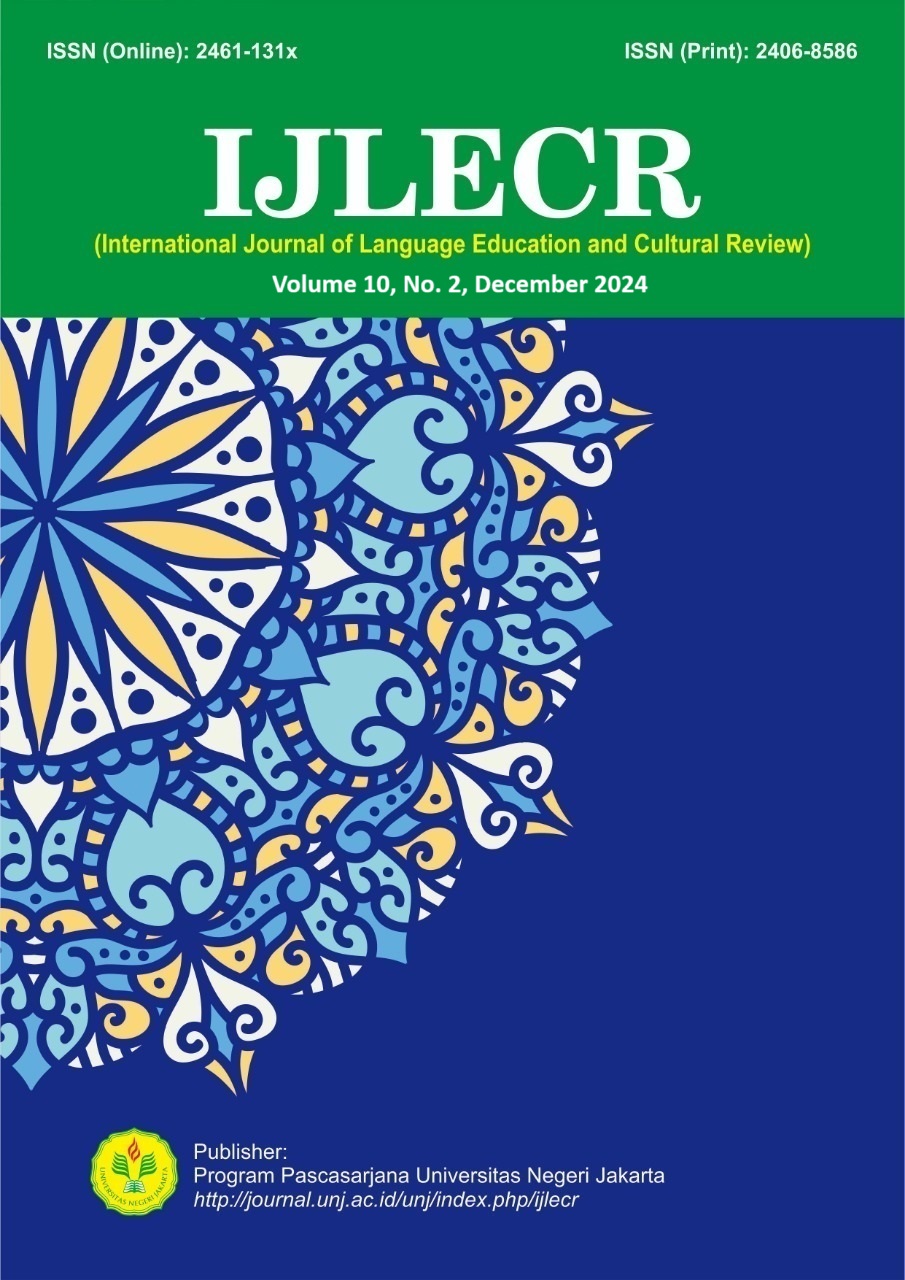The Effectiveness of the Talking Stick Method in Improving Viewing Skills in the Digital Age
DOI:
https://doi.org/10.21009/ijlecr.v10i2.49484Kata Kunci:
Talking Stick, Viewing Skills, Critical Thinking, Short Films, Visual LearningAbstrak
This research was motivated by the weak viewing skills of students due to the minimal opportunities to practice viewing in the learning process. This study aims to analyze the effectiveness of the application of the talking stick method in improving students viewing skills, visual analysis, and critical thinking in the digital era, especially in learning short films. The study was conducted on students of Class X Computer and Network Engineering (TKJ) at SMK Negeri 2 Bengkulu Tengah using a descriptive qualitative approach. Data were collected through observation, interviews, and pretest-posttest to see the development of students’ abilities after the application of the talking stick method. The results showed a significant increase in the final test scores compared to the initial test across all students, with an average increase range of 18 to 23 points. The talking stick method has been shown to increase student engagement in class discussions, improve their understanding of cinematic elements, such as storylines, characters, and symbolism, and strengthen critical and analytical thinking skills. In addition, this method is effective for application at various levels of student ability, both students with low and high initial scores. Thus, this study provides strong evidence that the talking stick method is an effective approach in visual-based learning and interactive discussions, especially in the context of learning short films in SMK.
Referensi
Abidin, Y. (2019). Multimodalitas dalam pembelajaran bahasa Indonesia. blog spot.com. https://irfes.blogspot.com/2019/03/multimodalitas-dalam-pembelajaran.html
Antara, I. K. B., Kristiantari, M. G. R., & Suadnyana, I. N. (2019). Pengaruh model pembelajaran talking stick berbantuan rubrik surat kabar terhadap keterampilan berbicara. International Journal of Elementary Education, 3(4), 423. https://doi.org/10.23887/ijee.v3i4.21315
Burmark, L. (2018). Visual literacy: Learn to see, see to learn. ASCD.
Cahya, P., & Purnanto, A. W. (2023). Analisis model pembelajaran memirsa di kelas 2 SD IT Muhammadiyah Bandongan Kabupaten Magelang. JIIP - Jurnal Ilmiah Ilmu Pendidikan, 6(12), 9939–9947. https://doi.org/10.54371/jiip.v6i12.2492
Chi, M. T. H. (2018). Active-constructive-interactive: A conceptual framework for differentiating learning activities. Topics in Cognitive Science, 1(1), 73–105.
Faloye, B. O., Obateru, O. T., & Alonge, A. (2021). Active learning in the 21st century: The role of talking stick method. Contemporary Education Research.
Gabinete, L. (2017). Visual media and education: Enhancing critical thinking skills. Educational Innovations Press.
Gabinete, M. K. L. (2017). Teachers’ beliefs and practices in assessing the viewing skill of ESL learners. Indonesian Journal of Applied Linguistics, 7(1), 19–28. https://doi.org/10.17509/ijal.v7i1.6854
Hussain, F., Nawaz, H., & Ali, R. (2019). Impact of active learning strategies on students’ performance and critical thinking skills. Journal of Education and Practice, 10(2), 45–51. https://doi.org/10.7176/JEP/10-2-45
Jewitt, C., Bezemer, J., & O’Halloran, K. (2019). Introducing multimodality: Enhancing learning through multiple modes. Routledge.
Kemendikbudristek. (2021). Kurikulum merdeka: Capaian pembelajaran berbasis teknologi. Kemendikbudristek.
Khoo, K. Y., & Churchill, D. (2018). Integrating media visual into education. Educational Technologies.
Li, X., & Zhao, Y. (2021). Effectiveness of collaborative learning in enhancing students’ learning outcomes: A meta-analysis. Educational Psychology Review, 33(3), 1013–1034. https://doi.org/10.1007/s10648-021-09570-9
Maleong, L. J. (2004). Penelitian kualitatif. PT Remaja Rosdakarya.
Mantiri, F. (2014). Multimedia and technology in learning. Universal Journal of Educational Research, 2(9), 589–592. https://doi.org/10.13189/ujer.2020.081278
Mayer, R. E. (2019). Multimedia learning: A cognitive theory of multimedia learning. Cambridge University Press.
Messaris, P. (2012). Visual “Literacy” in the digital age. Review of Communication, 12, 101–117. https://doi.org/10.1080/15358593.2011.653508
Mulyadi, Y., & Wikanengsih, W. (2022). Implementasi keterampilan berbahasa memirsa dalam capaian pembelajaran kurikulum prototipe mata pelajaran bahasa Indonesia kelas X pada program sekolah penggerak. Semantik, 11(1), 47–60. https://doi.org/10.22460/semantik.v11i1.p47-60
Nasir, M., Anwar, A., & Syed, N. (2021). The influence of collaborative learning on low-achieving students in secondary education. International Journal of Educational Research, 105, 78–89. https://doi.org/10.1016/j.ijer.2020.101653
Prabawaningtyas, I., & Purnanto, W. A. (2023). Analisis model pembelajaran memirsa pada siswa kelas 1 di SD Muhammadiyah Payaman. LITERASI: Jurnal Ilmu …, 457–465. https://ejournal.almaata.ac.id/index.php/LITERASI/article/view/3381%0Ahttps://ejournal.almaata.ac.id/index.php/LITERASI/article/download/3381/2066
Pratiwi, D., Brillianing, H., & Puspito Hapsari, P. (2020). Visual stimulus and its impact on critical thinking skills. International Journal of Education, 12(1), 89–102.
Rahman, A., Yusuf, M., & Arifin, Z. (2020). The role of group discussion in enhancing critical thinking in higher education: An empirical study. Journal of Education and Learning, 9(3), 15–23. https://doi.org/10.5539/jel.v9n3p15
Rahman, H., Wirawati, D., & Sidiq, J. N. A. (2020). Pembentukan karakter melalui pembelajaran sastra berbasis ekologis dalam kumpulan cerita rakyat nusantara. Pena Literasi, 2(2), 87. https://doi.org/10.24853/pl.2.2.244-249
Santos, L., & Correia, P. (2022). The impact of social learning and peer collaboration in enhancing student learning. Journal of Educational Psychology, 114(4), 621–635. https://doi.org/10.1037/edu0000689
Sarah, R. A. P., Yusman, A. F., Bentri, A., & Darmansyah, D. (2023). Implementation learning model cooperative course review horay (crh) with talking stick to student learning outcomes. Research and Development Journal of Education, 9(1), 321. https://doi.org/10.30998/rdje.v9i1.16521
Sastrawan, P. A. P., & Sudana, D. N. (2021). Mind mapping assisted talking stick learning model on speaking skills. Journal of Education Technology, 4(4), 495. https://doi.org/10.23887/jet.v4i4.27103
Sugiantiningsih, I. A., & Antara, P. A. (2019). Penerapan model pembelajaran talking stick berbantuan media flash card untuk meningkatkan kemampuan berbicara. Jurnal Ilmiah Pendidikan Profesi Guru, 2(3). https://doi.org/10.23887/jippg.v2i3.15728
Wahyuningsih, Y., & Purnanto, A. W. (2023). Analysis the “memirsa” skill learning model for primary school students. Edunesia : Jurnal Ilmiah Pendidikan, 5(1), 156–171. https://doi.org/10.51276/edu.v5i1.606
Wang, H., & Hu, Y. (2023). Visual literacy in 21st century education: Exploring the role of visual-based learning in enhancing critical thinking skills. International Journal of Education Technology, 17(1), 89–102. https://doi.org/10.1016/j.ijeduc.2023.102050
Woottipong, K. (2014). Video in language learning: Enhancing student engagement and critical thinking. Journal of Education and Learning, 9(4).
Zyam, N. S. S., & Umam, N. K. (2022). Analisis keterampilan memirsa pada video pembelajaran cerita rakyat melalui whatsapp. Journal of Elementary Education, 05(04), 645–652.








